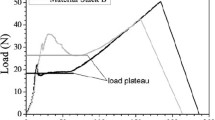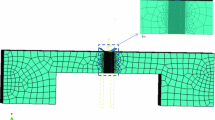Abstract
A well-known four-point bending test has been modified such that the critical energy release rate \(\mathcal{G}_c \) for delaminating cracks propagating at the interface of a thin, brittle layer bonded to a substrate can be measured. The energy release rate \(\mathcal{G} \) required for crack delaminating at those interfaces is obtained by attaching a stiffening layer to the layer system. Another advantage of this modification is that segmentation of the layer and plastic deformation of the substrate during bending are avoided. The interface fracture energy \(\mathcal{G}_c \) of a plasma sprayed ZrO2-ceramic layer on a flame sprayed high alloyed steel substrate has been measured.
Similar content being viewed by others
References
Cannon, R.M., Dalgleish, B.J., Daustkart, R.K., Oh, T.S. and Ritchie, R.O. (1991). Cyclic fatigue-crack propagation along ceramic/metal interfaces. Acta Metallurgica et Materialia 39, 2145-2156.
Cazzato, A. and Faber, K.T. (1997). Fracture energy of glass-alumina interfaces via the bimaterial bend test. Journal of the American Ceramic Society 80, 181-188.
Charalambides, P.G., Lund, J., Evans, A.G. and McMeeking, R.M. (1989). A test specimen for determining the fracture resistance of bimaterial interfaces. ASME Journal of Applied Mechanics 56, 77-82.
Evans, A.G., Drory, M.D. and Hu, M.S. (1988). The cracking and decohesion of thin films. Journal of the Materials Research Society 3, 1043-1049.
Evans, A.G., He, M.Y. and Hutchinson, J.W. (1989). Interface debonding and fiber cracking in brittle matrix composites. Journal of the American Ceramic Society 72, 2300-2303.
He, M.Y. and Hutchinson, J.W. (1989). Kinking of a crack out of an interface. Journal of Applied Mechanics 56, 270-278.
He, M.Y., Turner, M.R. and Evans, A.G. (1995). Analysis of the double cleavage drilled compression specimen for the interface fracture energy measurements over a range of mode mixties. Acta Metallurgica et Materialia 43, 3453-3458.
Kanninen, M.F. and Popelar, C.H. (1985). Advanced Fracture Mechanics, Oxford University Press, New York, 160.
Turner, M.R., Dalgleish, B.J., He, M.Y. and Evans, A.G. (1995). A fracture resistance measurement method for bimaterial interfaces heaving large debond energy. Acta Metallurgica et Materialia 43, 3459-3465.
Veddac für Windows Version 2.4. (1996). Software zur Verschiebungsanalyse durch Grauwertkorrelation an digitalisierten Bildern, Chemnitzer Werkstoffmechanik GmbH.
Rights and permissions
About this article
Cite this article
Hofinger, I., Oechsner, M., Bahr, HA. et al. Modified four-point bending specimen for determining the interface fracture energy for thin, brittle layers. International Journal of Fracture 92, 213–220 (1998). https://doi.org/10.1023/A:1007530932726
Issue Date:
DOI: https://doi.org/10.1023/A:1007530932726




